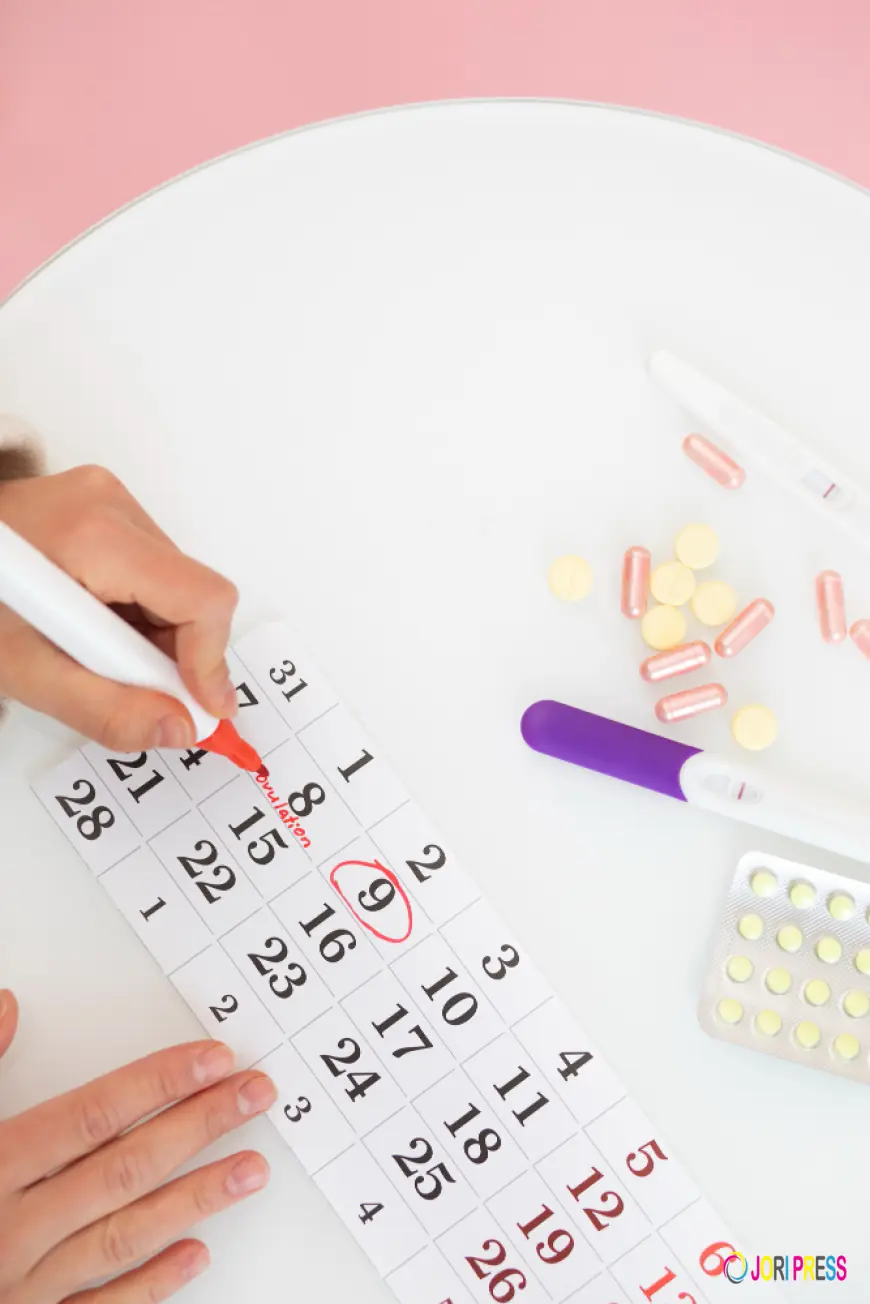How an Ovulation Calculator Can Help Track Your Menstrual Health
An ovulation calculator is an online or digital tool that estimates a woman's most fertile days based on information such as the first day of her last menstrual period and the average length of her menstrual cycle. It uses this data to predict when ovulation is likely to occur. While it cannot guarantee exact dates, it provides a reliable estimate that can be used for family planning or monitoring menstrual health.

Tracking menstrual health is an essential aspect of understanding a woman's overall well-being. Many women experience irregular cycles, unpredictable ovulation, or symptoms that can indicate underlying health issues. An ovulation calculator is a modern tool that can provide valuable insights into the menstrual cycle, helping women track fertility, predict ovulation, and maintain hormonal balance. By understanding how to use an ovulation calculator effectively, women can gain control over their reproductive health and detect potential problems early.
Understanding the Basics of an Ovulation Calculator
What Is an Ovulation Calculator
An is an online or digital tool that estimates a woman's most fertile days based on information such as the first day of her last menstrual period and the average length of her menstrual cycle. It uses this data to predict when ovulation is likely to occur. While it cannot guarantee exact dates, it provides a reliable estimate that can be used for family planning or monitoring menstrual health.
How It Works
The calculator typically relies on the understanding that ovulation occurs roughly 14 days before the start of the next period in a regular menstrual cycle. By entering the cycle length and the first day of the last period, the calculator estimates the fertile window, which usually spans five to six days. This period includes the day of ovulation and the days leading up to it when conception is most likely.
Benefits of Using an Ovulation Calculator
Tracking Menstrual Cycle Regularity
Using an ovulation calculator helps women monitor the consistency of their menstrual cycles. By entering period dates over several months, the calculator identifies patterns and irregularities. This can alert women to irregular cycles, which may be caused by hormonal imbalances, stress, or underlying medical conditions such as polycystic ovary syndrome (PCOS).
Predicting Fertile Windows
For women trying to conceive, an ovulation calculator highlights the fertile window, making it easier to plan intercourse during the days with the highest likelihood of conception. Understanding this timing is crucial because sperm can survive in the female reproductive tract for several days, while the egg is viable for only about 12 to 24 hours after ovulation.
Identifying Ovulation Problems
Women who struggle with fertility can use an ovulation calculator to detect potential ovulation issues. If the calculator shows that ovulation is consistently predicted on unusual days or the fertile window varies widely, it may indicate anovulation or irregular ovulation, prompting a consultation with a healthcare provider.
Enhancing Hormonal Awareness
Tracking ovulation with a calculator increases awareness of hormonal changes throughout the menstrual cycle. Estrogen and progesterone levels fluctuate during the cycle, affecting mood, energy, and physical symptoms. By knowing the likely ovulation days, women can correlate these changes with hormonal activity and manage symptoms like PMS or mood swings more effectively.
Common Features of Modern Ovulation Calculators
Personalized Predictions
Many ovulation calculators now allow for personalized predictions by considering cycle length variations and historical data. Some tools also track previous ovulation dates to improve future predictions, providing a more customized experience.
Integration with Health Apps
Modern calculators often integrate with health apps, enabling users to record symptoms, basal body temperature, cervical mucus changes, and other fertility indicators. This integration helps create a comprehensive picture of menstrual health beyond just ovulation dates.
Alerts and Reminders
Some ovulation calculators offer notifications to alert women about upcoming fertile windows or period dates. These reminders can help women plan family planning or track menstrual symptoms without constantly checking the app.
How to Use an Ovulation Calculator Effectively
Track Cycle Information Accurately
For the calculator to be effective, it is important to enter accurate cycle information. Women should note the first day of their period and the average cycle length over several months. Accurate input ensures that the predicted fertile window is as close to reality as possible.
Combine With Physical Signs
While calculators provide estimates, monitoring physical signs such as changes in cervical mucus, basal body temperature, or mild ovulation pain adds reliability. These signs confirm ovulation and make the tracking process more precise.
Update Regularly
Cycles can change due to stress, lifestyle factors, or health conditions. Updating the calculator with each new period ensures that predictions remain accurate and reflect current menstrual patterns.
Impact on Overall Menstrual Health
Early Detection of Irregularities
Using an ovulation calculator over time helps women identify irregular cycles, missed periods, or unexpected changes in cycle length. Early detection allows for timely intervention, reducing the risk of complications and improving reproductive health outcomes.
Managing Fertility Naturally
For women who prefer natural family planning methods, ovulation calculators provide a non-invasive and medication-free way to monitor fertility. It empowers women to understand their reproductive cycle and make informed decisions about conception or contraception.
Supporting Conversations With Healthcare Providers
Data collected through ovulation calculators can be shared with healthcare providers. This information aids in diagnosing menstrual or fertility issues, guiding treatment plans, and understanding individual reproductive patterns.
Promoting Lifestyle Adjustments
Awareness of ovulation and menstrual health can motivate women to make lifestyle changes that improve reproductive health. Regular exercise, balanced nutrition, stress management, and adequate sleep can positively influence ovulation patterns and hormonal balance.
Limitations to Keep in Mind
Estimates, Not Certainties
It is important to remember that ovulation calculators provide estimates, not exact dates. Factors such as illness, stress, travel, or hormonal changes can affect ovulation timing, so predictions may not always be accurate.
Not a Substitute for Medical Advice
While ovulation calculators are useful, they do not replace professional medical advice. Women experiencing irregular cycles, difficulty conceiving, or other menstrual health concerns should consult a healthcare provider for personalized guidance.
May Be Less Accurate for Irregular Cycles
Women with irregular menstrual cycles may find ovulation calculators less accurate because predictions are based on average cycle lengths. Combining calculators with other fertility tracking methods can improve reliability.
Tips for Maximizing the Benefits of an Ovulation Calculator
Track cycles consistently and input accurate data for each period
Combine the calculator with physical fertility signs for more precise tracking
Use additional tools such as ovulation predictor kits or fertility apps if needed
Share cycle data with healthcare providers for personalized advice
Stay mindful of lifestyle factors that can influence menstrual health
Conclusion
An ovulation calculator is a powerful tool for tracking menstrual health, predicting fertile windows, and enhancing awareness of reproductive patterns. By using it accurately and combining it with physical signs, women can gain insights into their cycles, detect irregularities, and manage fertility more effectively. While it is not a substitute for medical advice, it provides a convenient, non-invasive method to monitor menstrual health and support overall reproductive wellness. Regular use and careful tracking can empower women to take charge of their menstrual health and make informed decisions regarding family planning and lifestyle adjustments.
What's Your Reaction?
 Like
1
Like
1
 Dislike
0
Dislike
0
 Love
0
Love
0
 Funny
0
Funny
0
 Angry
0
Angry
0
 Sad
0
Sad
0
 Wow
0
Wow
0

















































